Social Determinants of Health among Adults with Diagnosed HIV Infection, 2018: Figures
Figure 1. Diagnoses of HIV infection among adults, by age at diagnosis, sex at birth, and federal poverty status, 2018—census tract level, United States and Puerto Rico
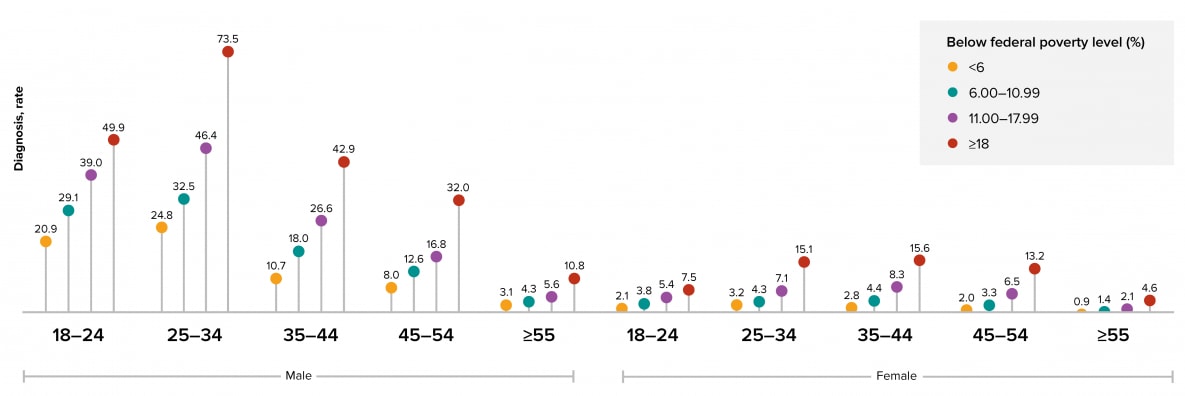
Figure 2. Diagnoses of HIV infection among adults, race/ethnicity, sex at birth, and federal poverty status, 2018—census tract level, United States and Puerto Rico
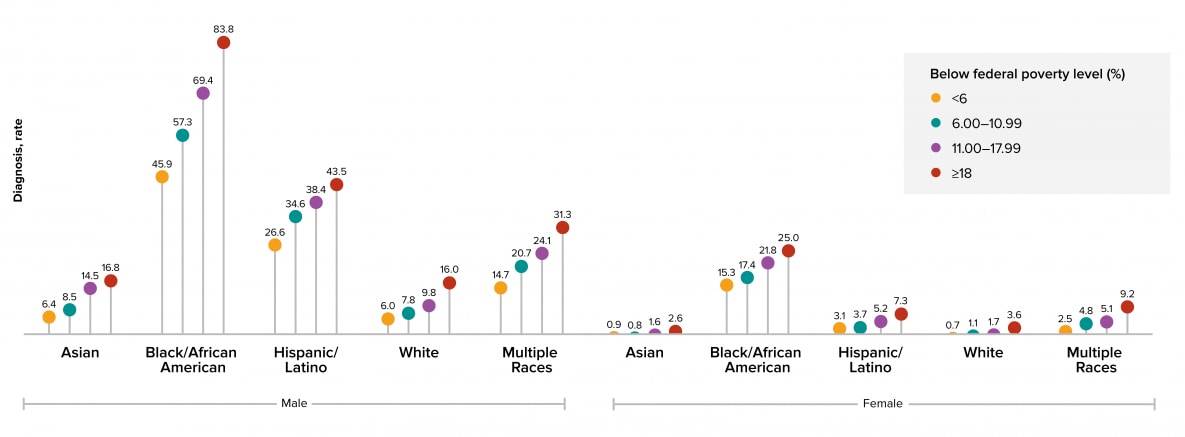
Note. Hispanics/Latinos can be of any race.
Figure 3. Diagnoses of HIV infection among adults, by transmission category, sex at birth, and federal poverty status, 2018—census tract level, United States and Puerto Rico
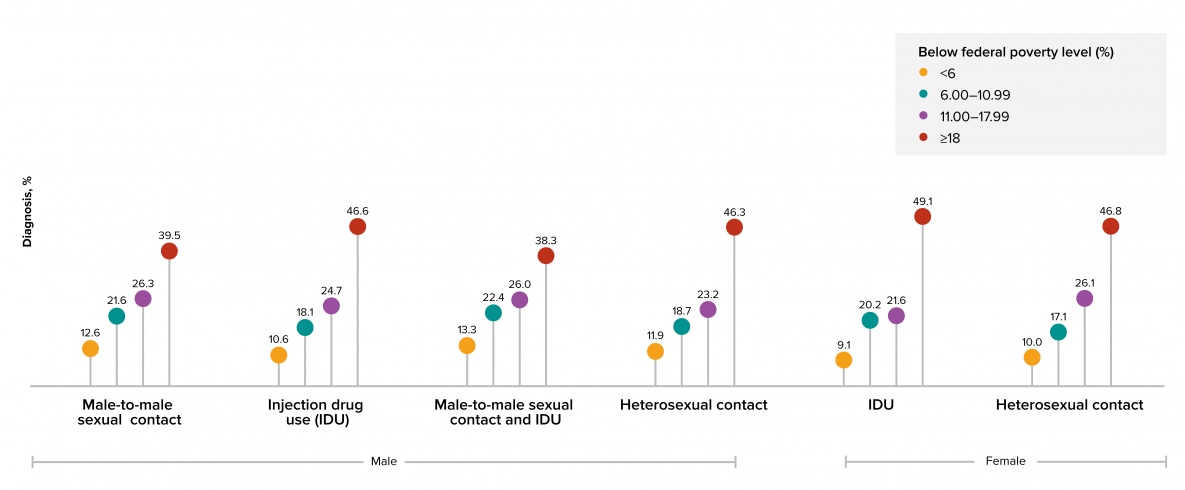
Note. Data have been statistically adjusted to account for missing transmission category. See Data Tables, Definitions, and Acronyms for more information on transmission categories.
Figure 4. Diagnoses of HIV infection among adults, by age at diagnosis, sex at birth, and education status, 2018—census tract level, United States and Puerto Rico
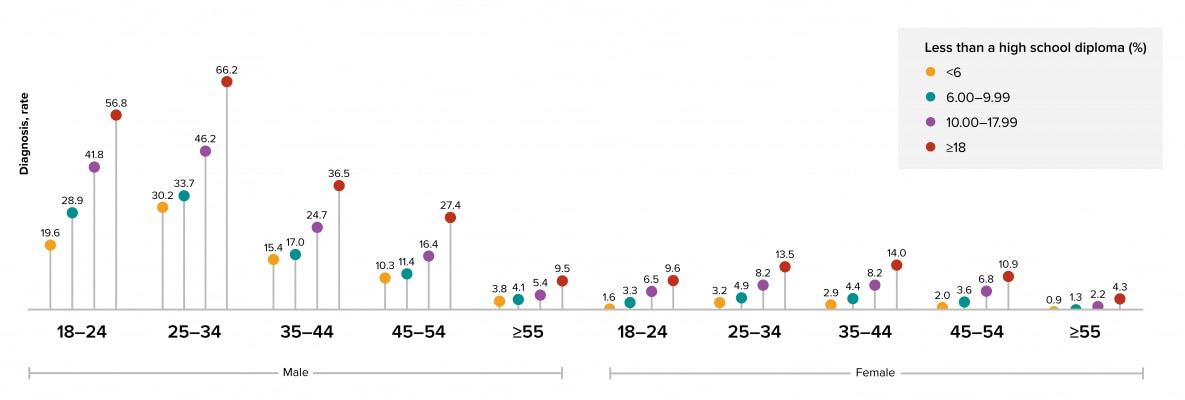
Figure 5. Diagnoses of HIV infection among adults, by race/ethnicity, sex at birth, and education status, 2018—census tract level, United States and Puerto Rico
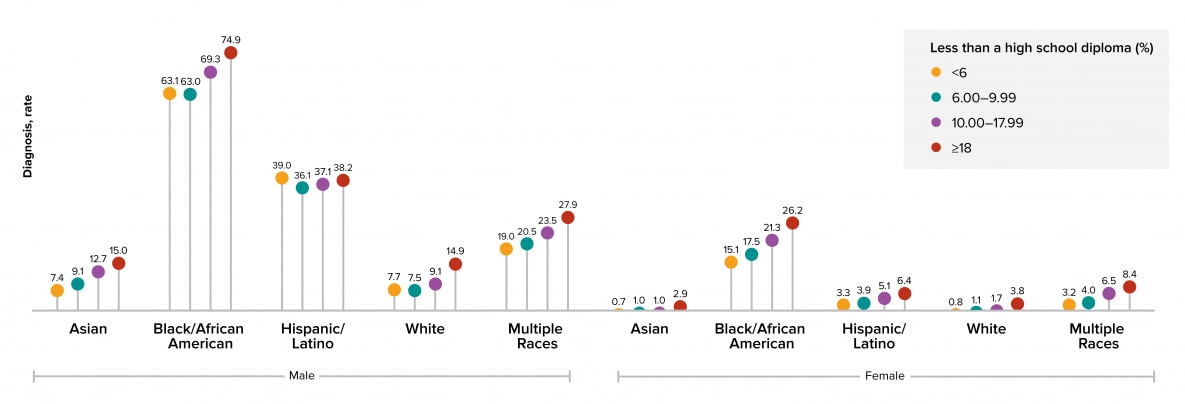
Note. Hispanics/Latinos can be of any race.
Figure 6. Diagnoses of HIV infection among adults, by transmission category, sex at birth, and education status, 2018—census tract level, United States and Puerto Rico
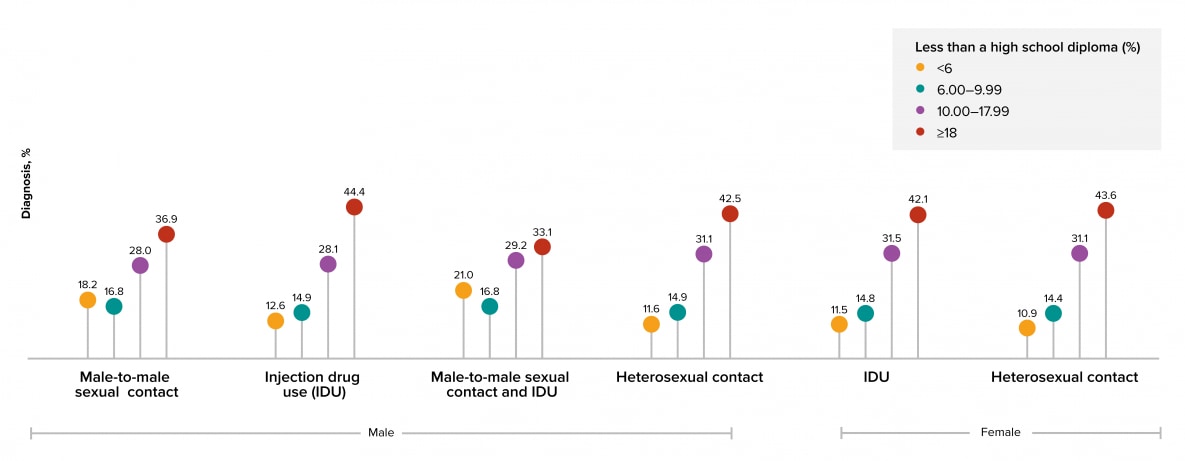
Note. Data have been statistically adjusted to account for missing transmission category. See Data Tables, Definitions, and Acronyms for more information on transmission categories.
Figure 7. Diagnoses of HIV infection among adults, by age at diagnosis, sex at birth, and income level, 2018—census tract level, United States and Puerto Rico
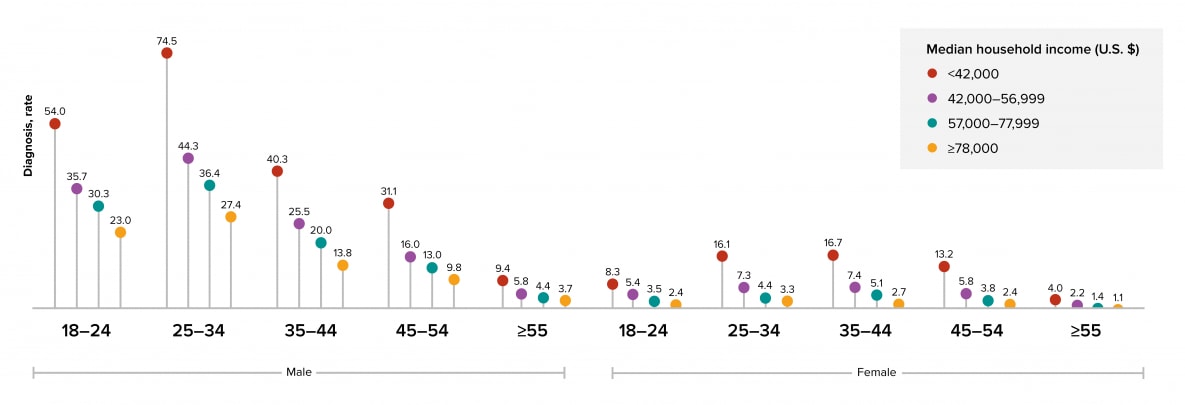
Figure 8. Diagnoses of HIV infection among adults, by race/ethnicity, sex at birth, and income level, 2018—census tract level, United States and Puerto Rico
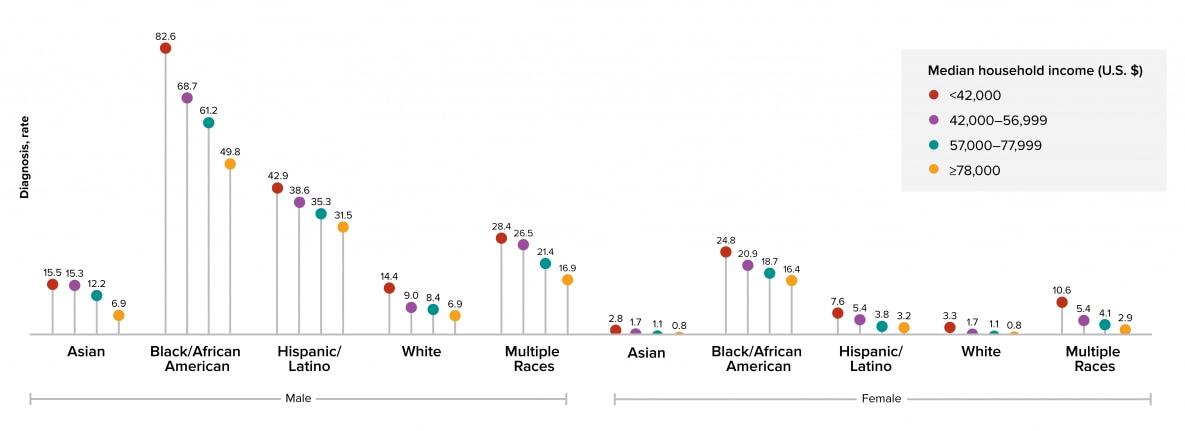
Note. Hispanics/Latinos can be of any race.
Figure 9. Diagnoses of HIV infection among adults, by transmission category, sex at birth, and income level, 2018—census tract level, United States and Puerto Rico
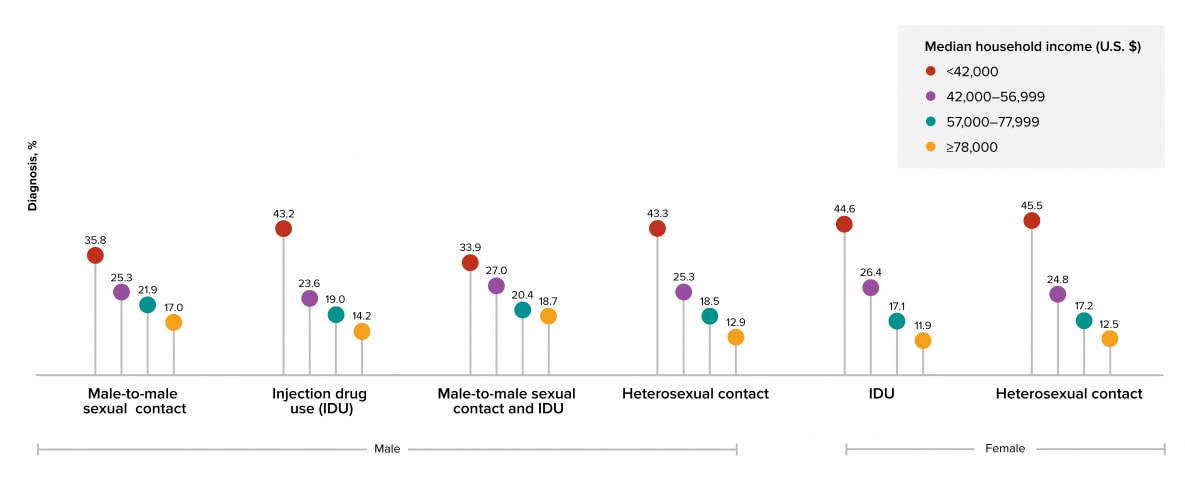
Note. Data have been statistically adjusted to account for missing transmission category. See Data Tables, Definitions, and Acronyms for more information on transmission categories.
Figure 10. Diagnoses of HIV infection among adults, by age at diagnosis, sex at birth, and health insurance coverage, 2018—census tract level, United States and Puerto Rico
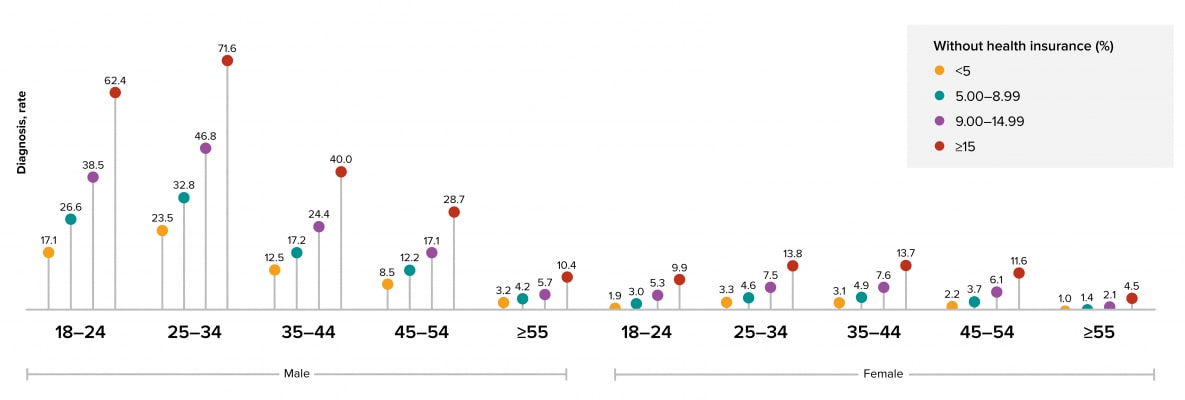
Figure 11. Diagnoses of HIV infection among adults, by race/ethnicity, sex at birth, and health insurance coverage, 2018—census tract level, United States and Puerto Rico
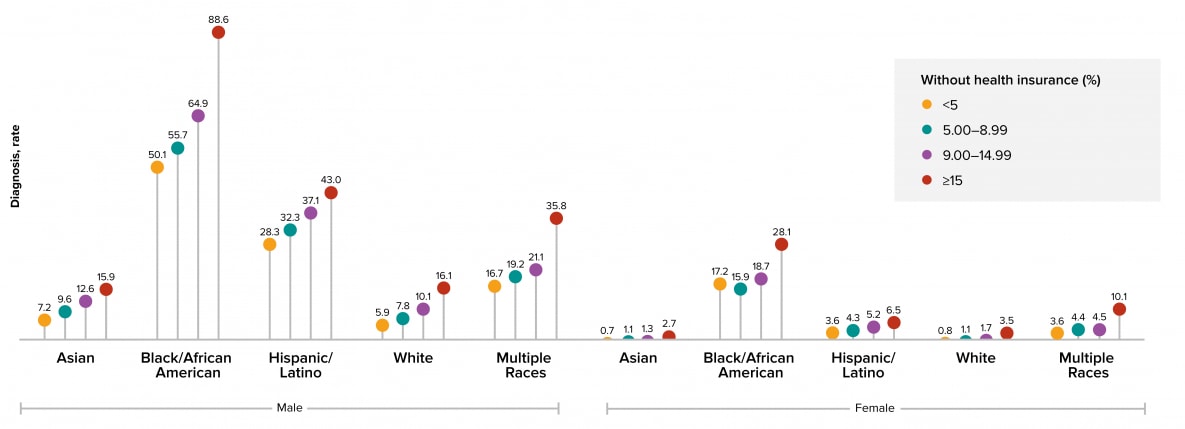
Note. Hispanics/Latinos can be of any race.
Figure 12. Diagnoses of HIV infection among adults, by transmission category, sex at birth, and health insurance coverage, 2018—census tract level, United States and Puerto Rico
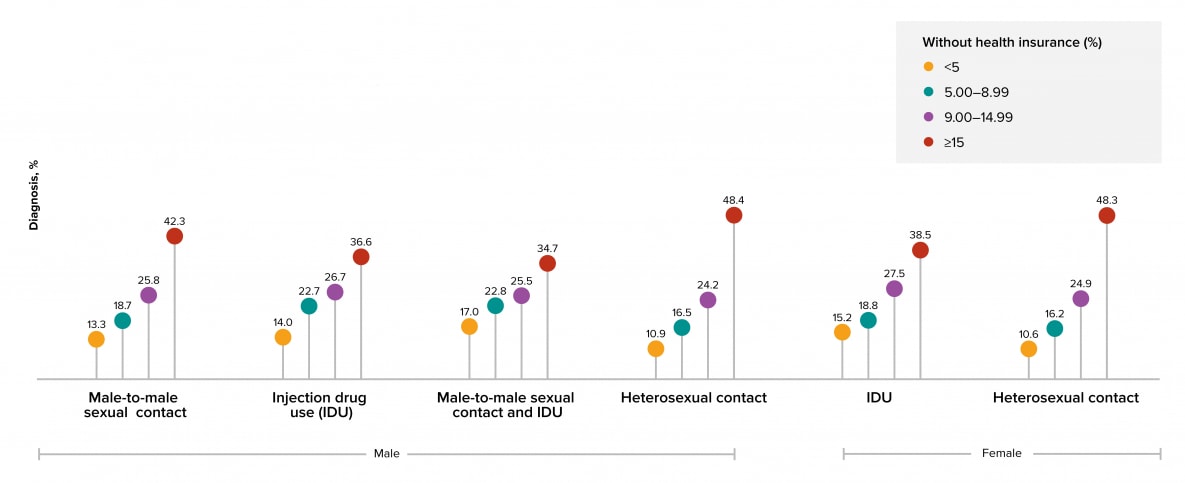
Note. Data have been statistically adjusted to account for missing transmission category. See Data Tables, Definitions, and Acronyms for more information on transmission categories.
Figure 13. Disparities of diagnoses of HIV infection among adult males, by race/ethnicity and poverty status, 2018—census tract level, United States and Puerto Rico
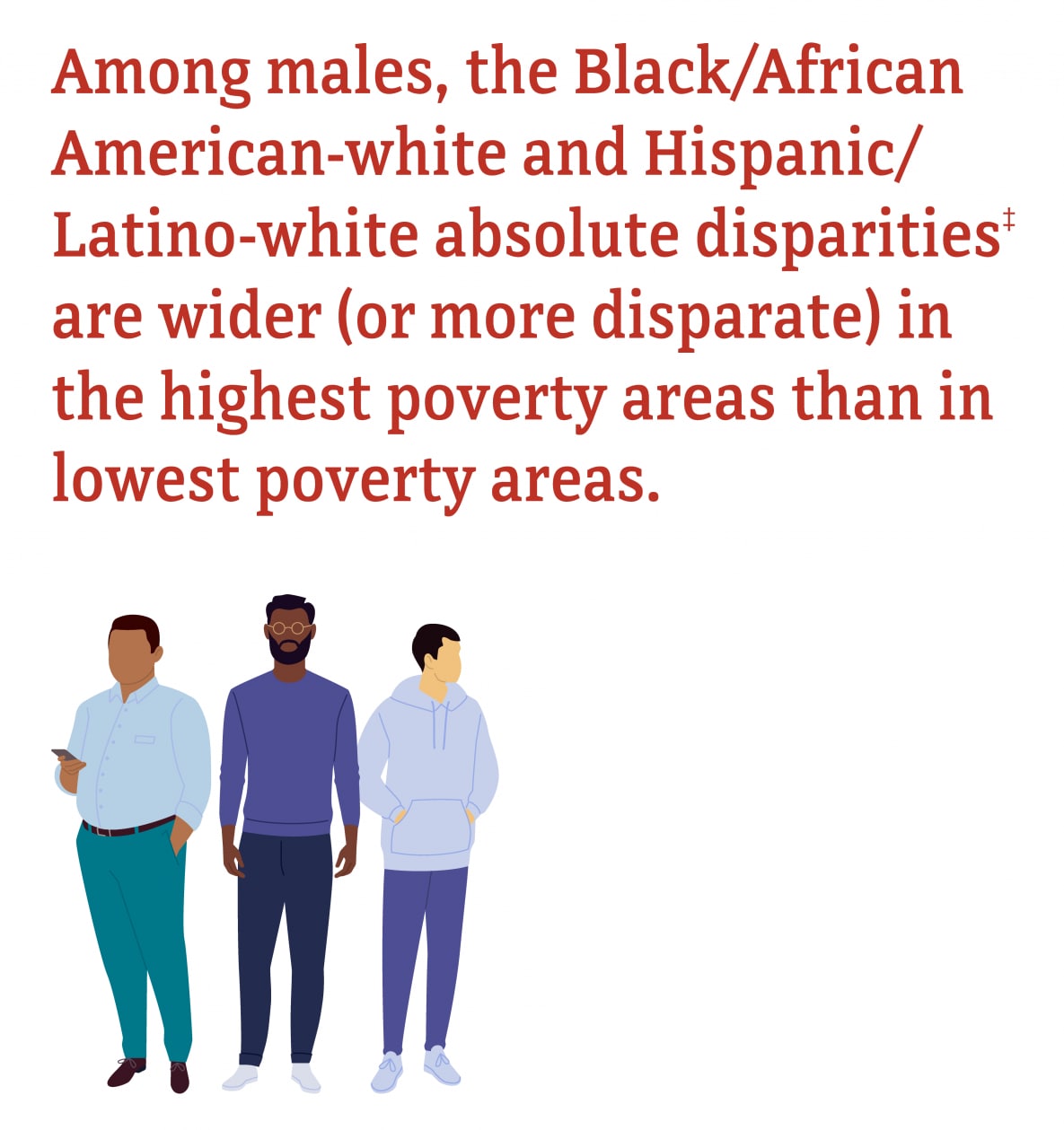
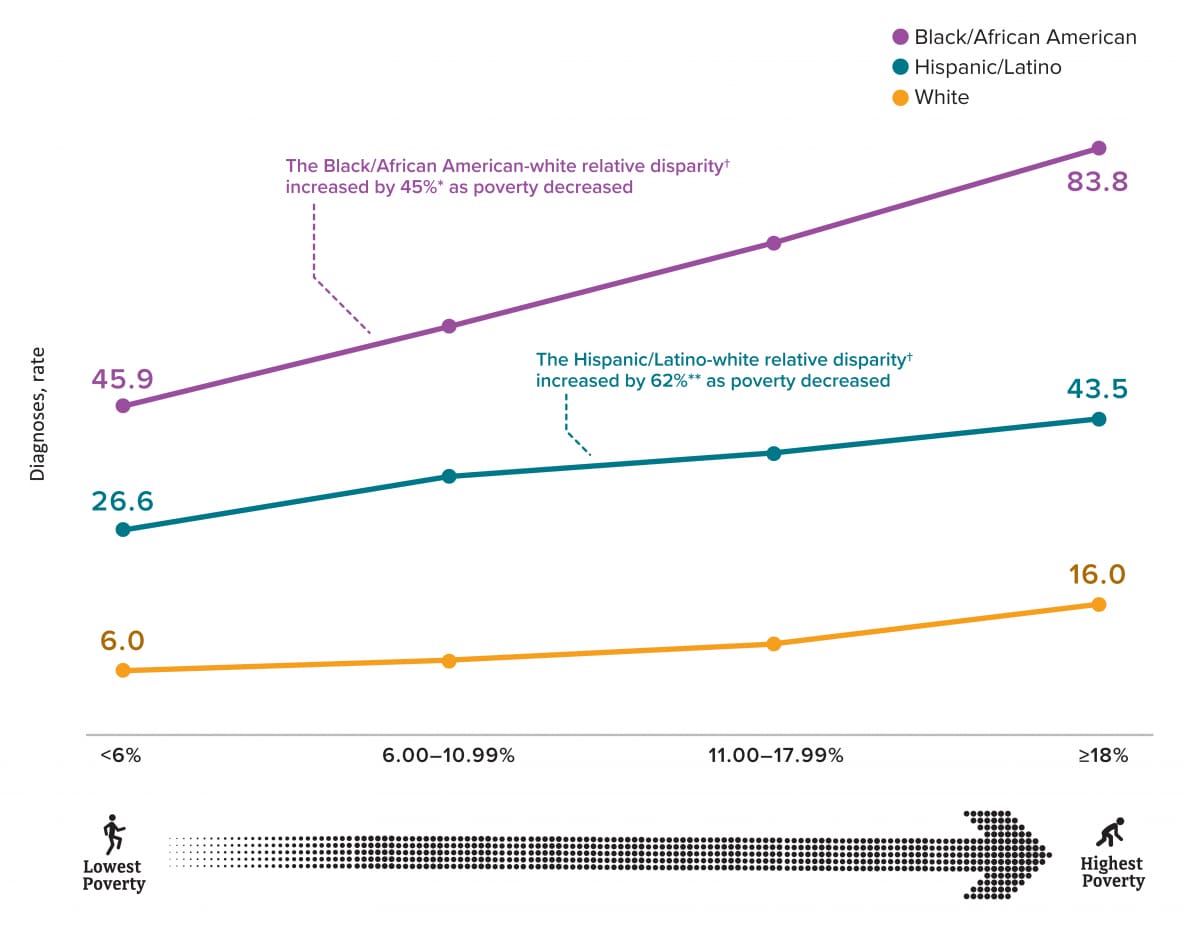
‡absolute disparity measures the difference between a group with the lowest rate and the group with the highest rate.
†relative disparity measures the ratio of the difference between the group rate and the overall population rate to the overall rate.
*45% increase is the lowest poverty disparity (45.9/6.0) compared to the highest poverty disparity (83.8/16.0).
**62% increase is the lowest poverty disparity (26.6/6.0) compared to the highest poverty disparity (43.5/16.0).
Figure 14. Disparities of diagnoses of HIV infection among adult females, by race/ethnicity and poverty status, 2018—census tract level, United States and Puerto Rico
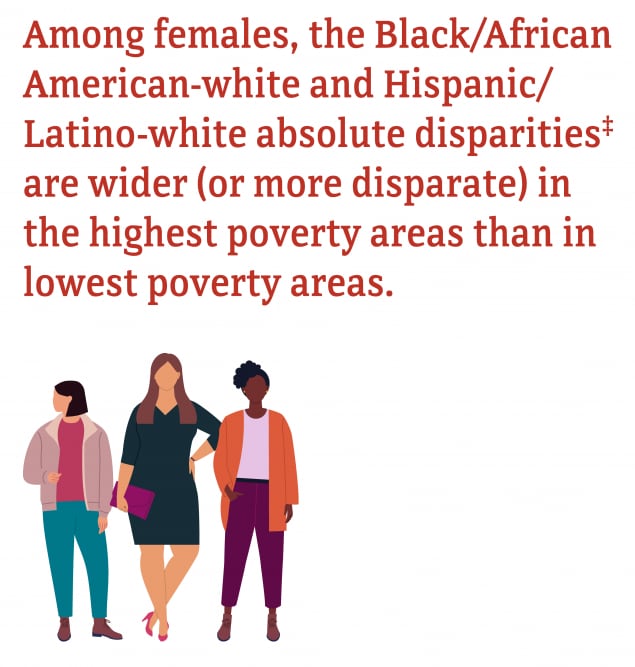
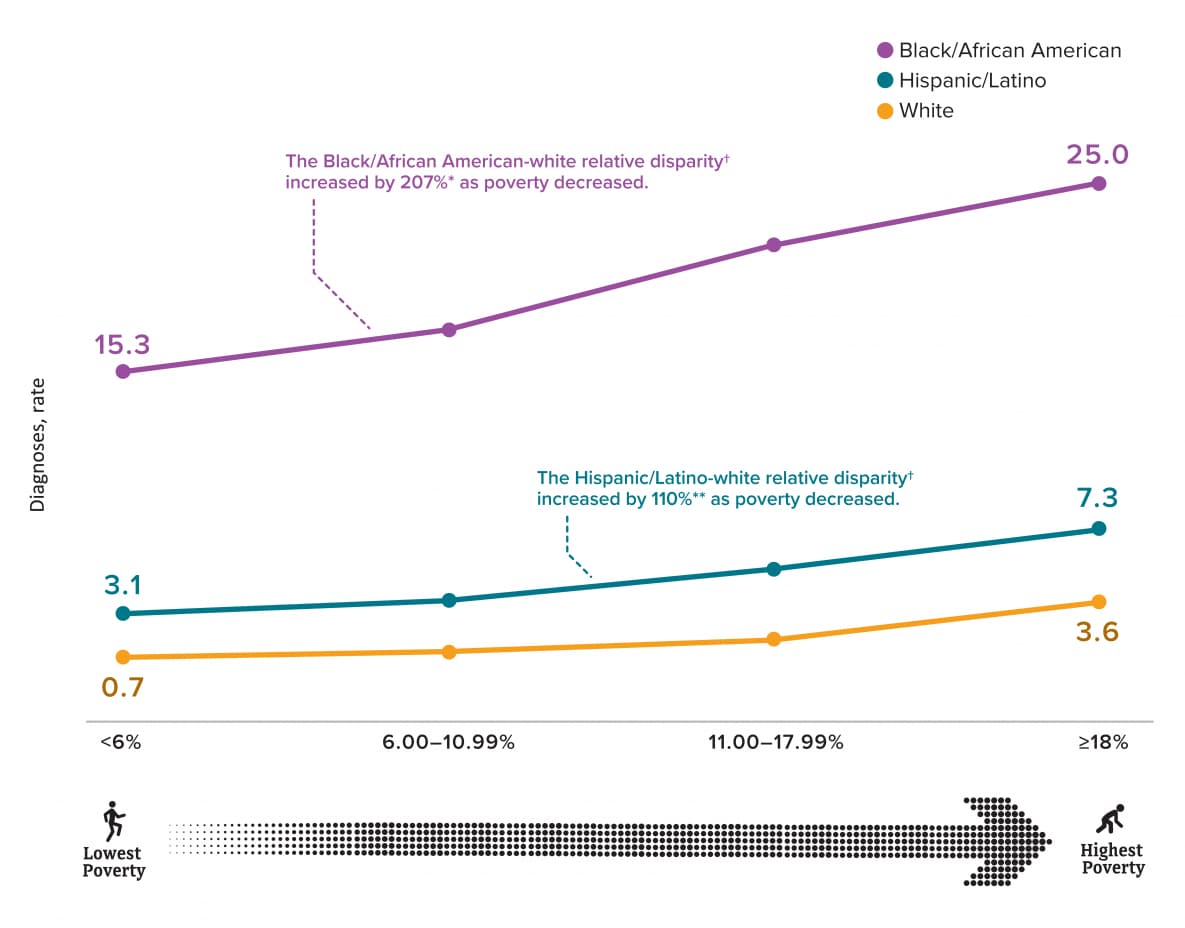
‡absolute disparity measures the difference between a group with the lowest rate and the group with the highest rate.
†relative disparity measures the ratio of the difference between the group rate and the overall population rate to the overall rate.
*207% increase is the lowest poverty disparity (15.3/0.7) compared to the highest poverty disparity (25.0/3.6).
**110% increase is the lowest poverty disparity (3.1/0.7) compared to the highest poverty disparity (7.3/3.6).
Figure 15. Disparities of diagnoses of HIV infection among adult males, by race/ethnicity and education status, 2018—census tract level, United States and Puerto Rico
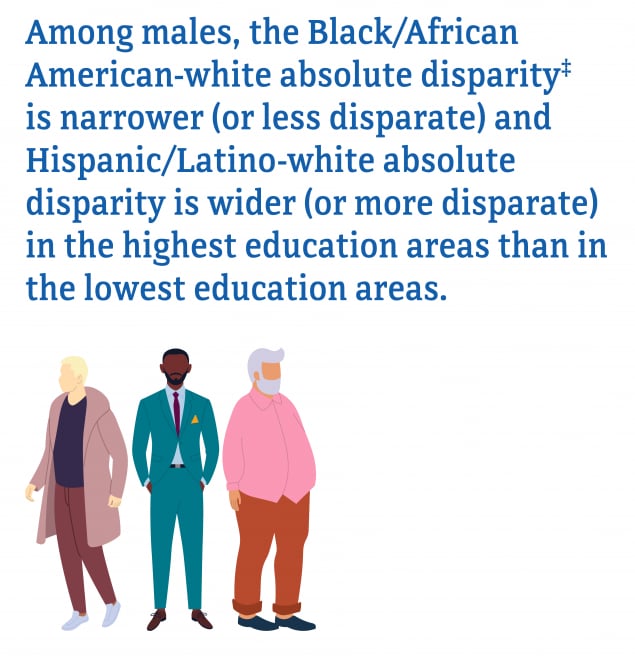
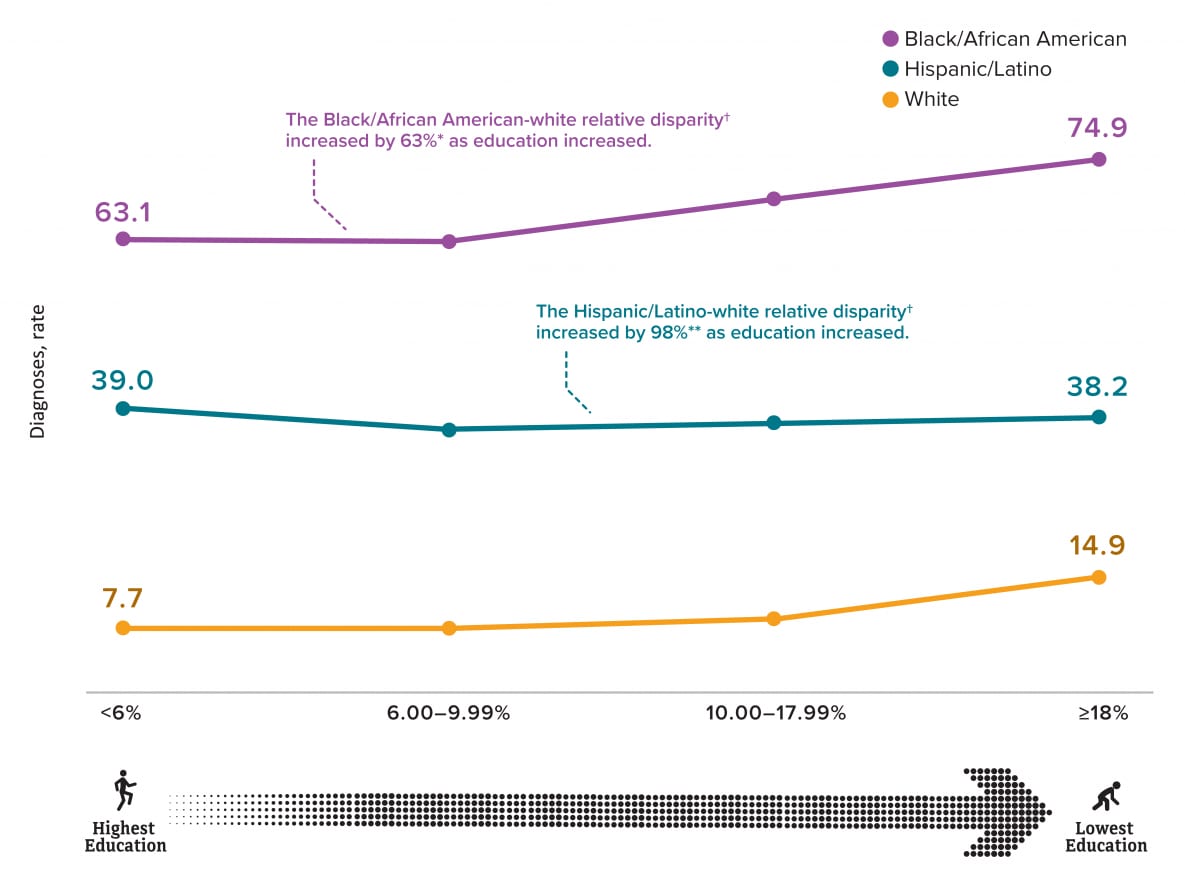
‡absolute disparity measures the difference between a group with the lowest rate and the group with the highest rate.
†relative disparity measures the ratio of the difference between the group rate and the overall population rate to the overall rate.
*63% increase is the lowest education disparity (74.9/14.9) compared to the highest education disparity (63.1/7.7).
**98% increase is the lowest education disparity (38.2/14.9) compared to the highest education disparity (39.0/7.7).
Figure 16. Disparities of diagnoses of HIV infection among adult females, by race/ethnicity and education status, 2018—census tract level, United States and Puerto Rico
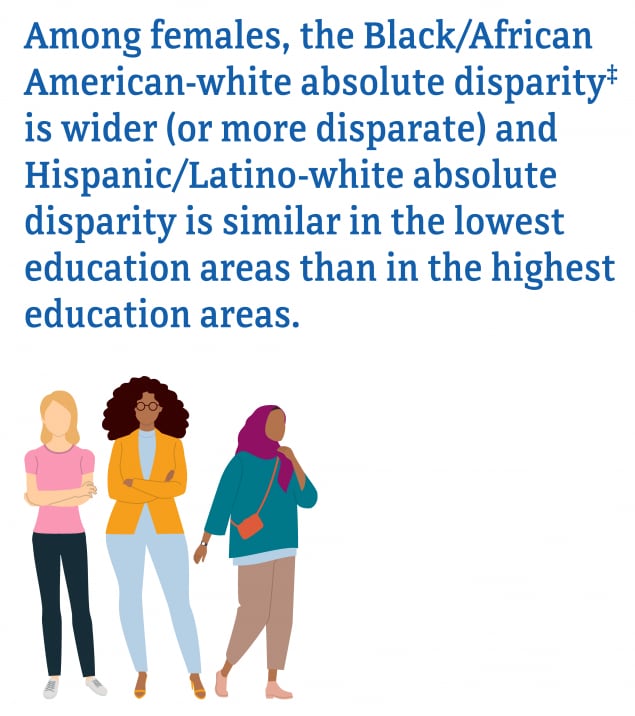
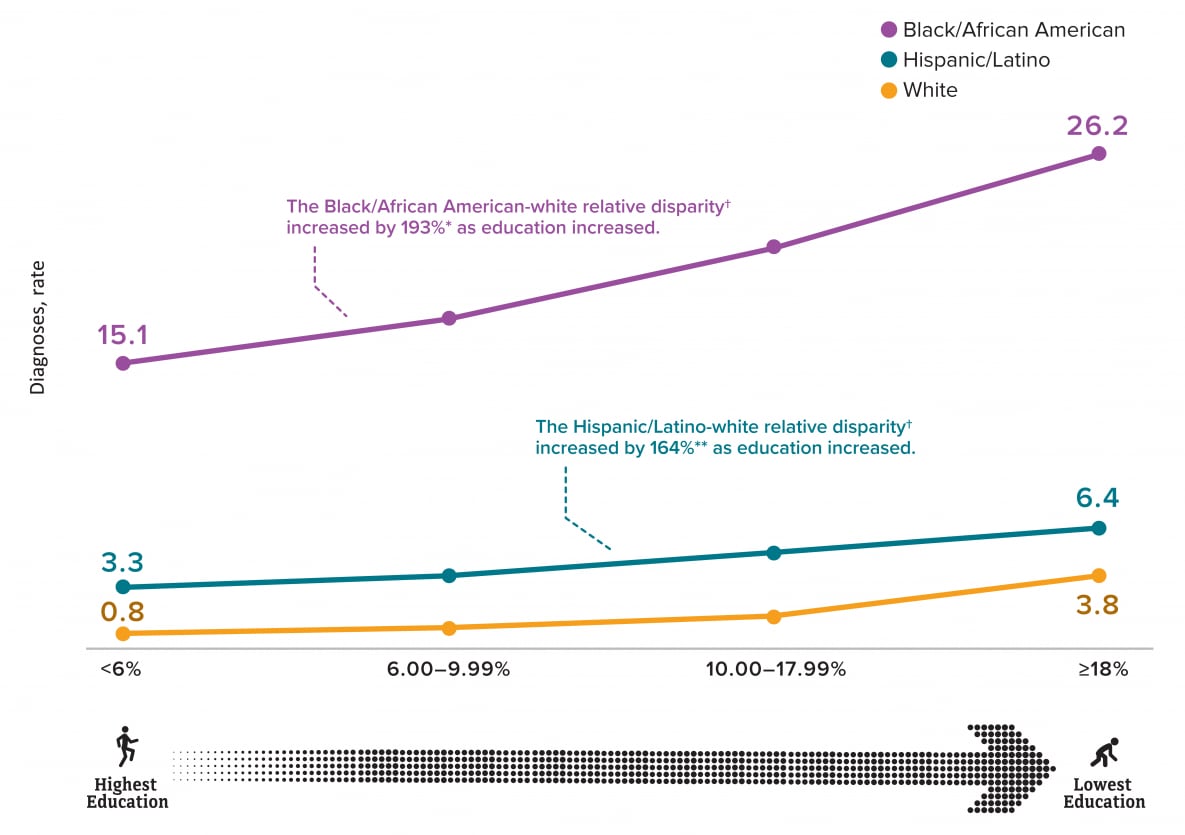
‡absolute disparity measures the difference between a group with the lowest rate and the group with the highest rate.
†relative disparity measures the ratio of the difference between the group rate and the overall population rate to the overall rate.
*193% increase is the lowest education disparity (26.2/3.8) compared to the highest education disparity (15.1/0.8).
**164% increase is the lowest education disparity (6.4/3.8) compared to the highest education disparity (3.3/0.8).
Figure 17. Disparities of diagnoses of HIV infection among adult males, by race/ethnicity and income level, 2018—census tract level, United States and Puerto Rico
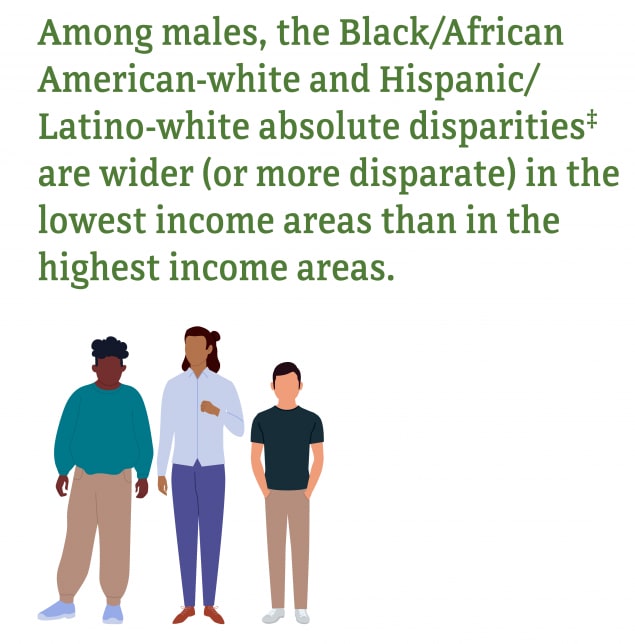
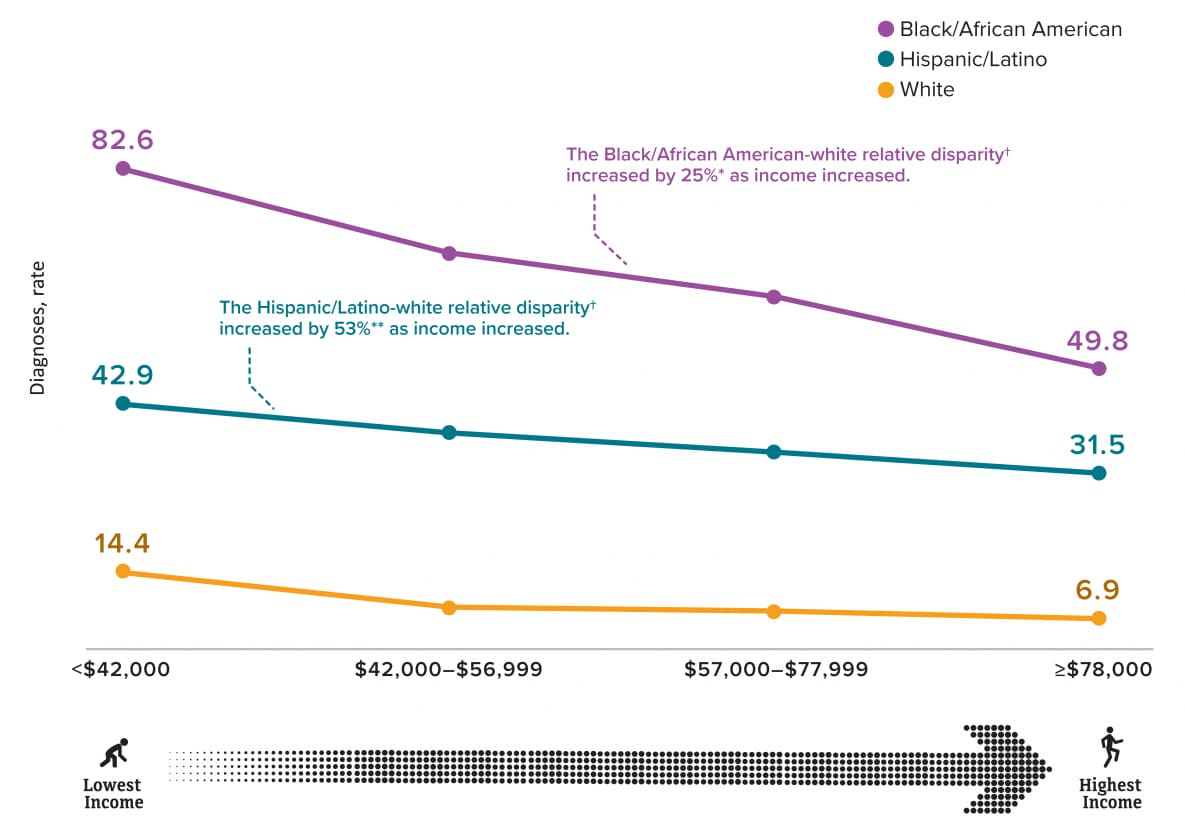
‡absolute disparity measures the difference between a group with the lowest rate and the group with the highest rate.
†relative disparity measures the ratio of the difference between the group rate and the overall population rate to the overall rate.
*25% increase is the lowest income disparity (82.6/14.4) compared to the highest income disparity (49.8/6.9).
**53% increase is the lowest income disparity (42.9/14.4) compared to the highest income disparity (31.5/6.9).
Figure 18. Disparities of diagnoses of HIV infection among adult females, by race/ethnicity and income level, 2018—census tract level, United States and Puerto Rico
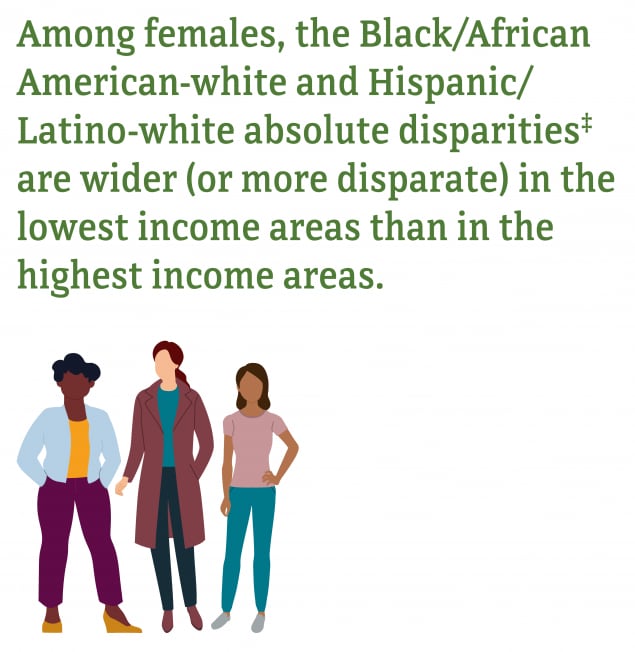
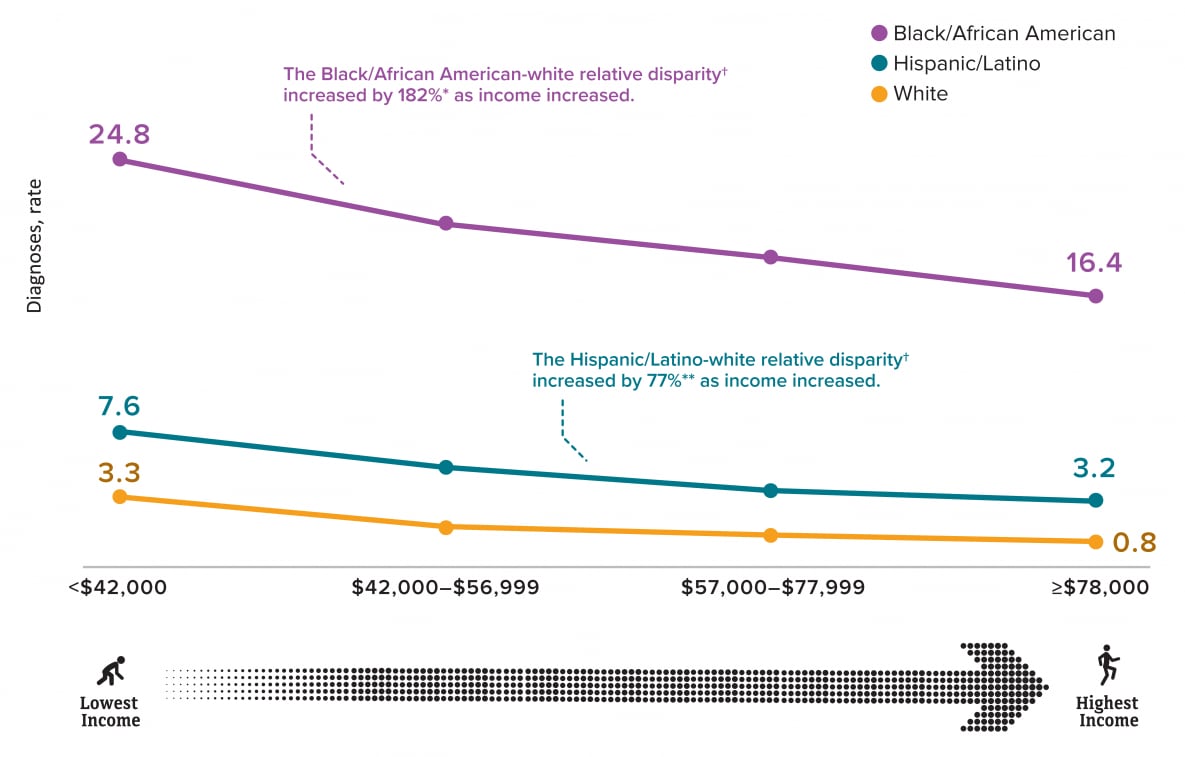
‡absolute disparity measures the difference between a group with the lowest rate and the group with the highest rate.
†relative disparity measures the ratio of the difference between the group rate and the overall population rate to the overall rate.
*182% increase is the lowest income disparity (24.8/3.3) compared to the highest income disparity (16.4/0.8).
**77% increase is the lowest income disparity (7.6/3.3) compared to the highest income disparity (3.2/0.8).
Figure 19. Disparities of diagnoses of HIV infection among adult males, by race/ethnicity and health insurance coverage, 2018—census tract level, United States and Puerto Rico
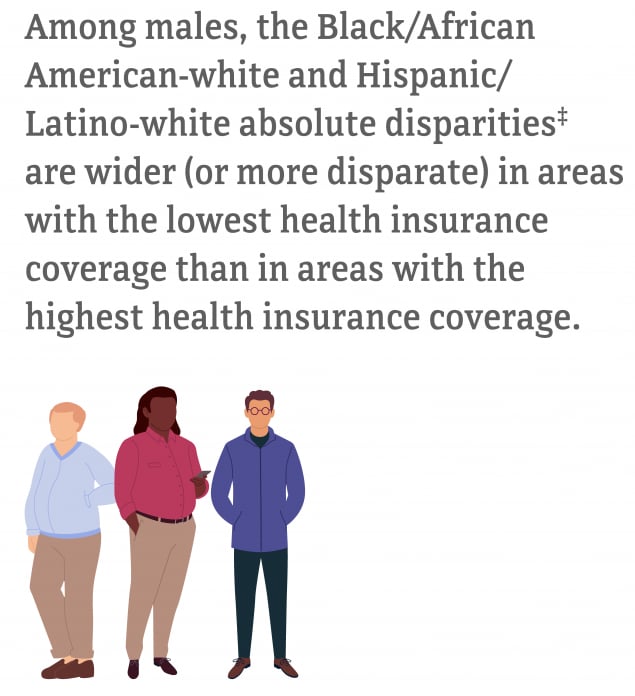
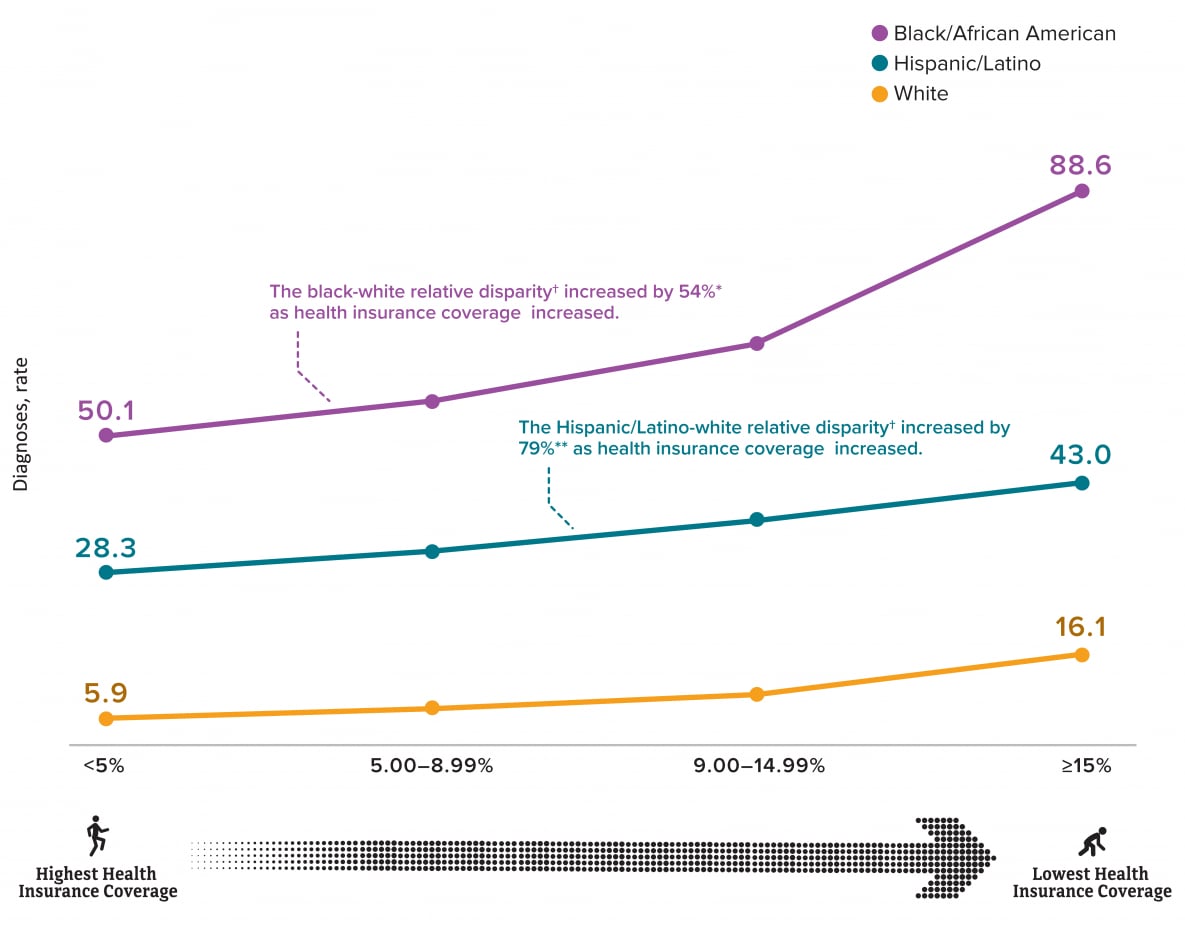
‡absolute disparity measures the difference between a group with the lowest rate and the group with the highest rate.
†relative disparity measures the ratio of the difference between the group rate and the overall population rate to the overall rate.
*54% increase is the lowest health insurance coverage (88.6/16.1) compared to the highest health insurance coverage (50.1/5.9).
**79% increase is the lowest health insurance coverage (43.0/16.1) compared to the highest health insurance coverage (28.3/5.9).
Figure 20. Disparities of diagnoses of HIV infection among adult males, by race/ethnicity and health insurance coverage, 2018—census tract level, United States and Puerto Rico
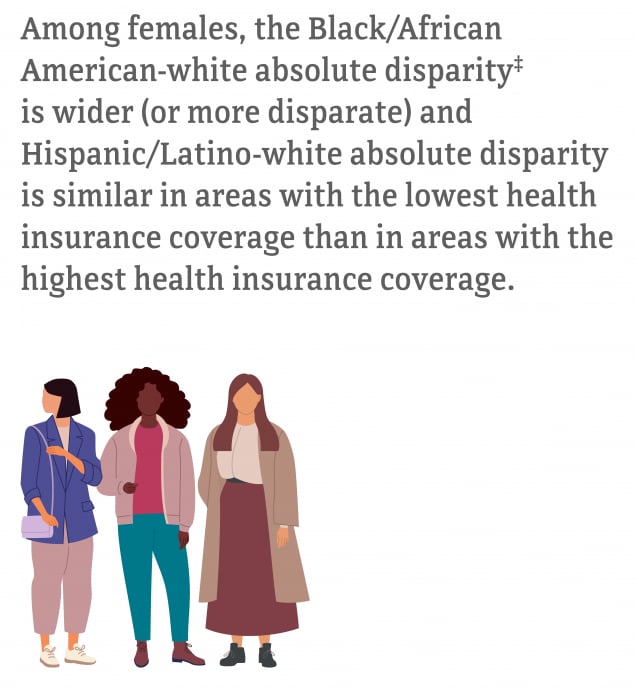
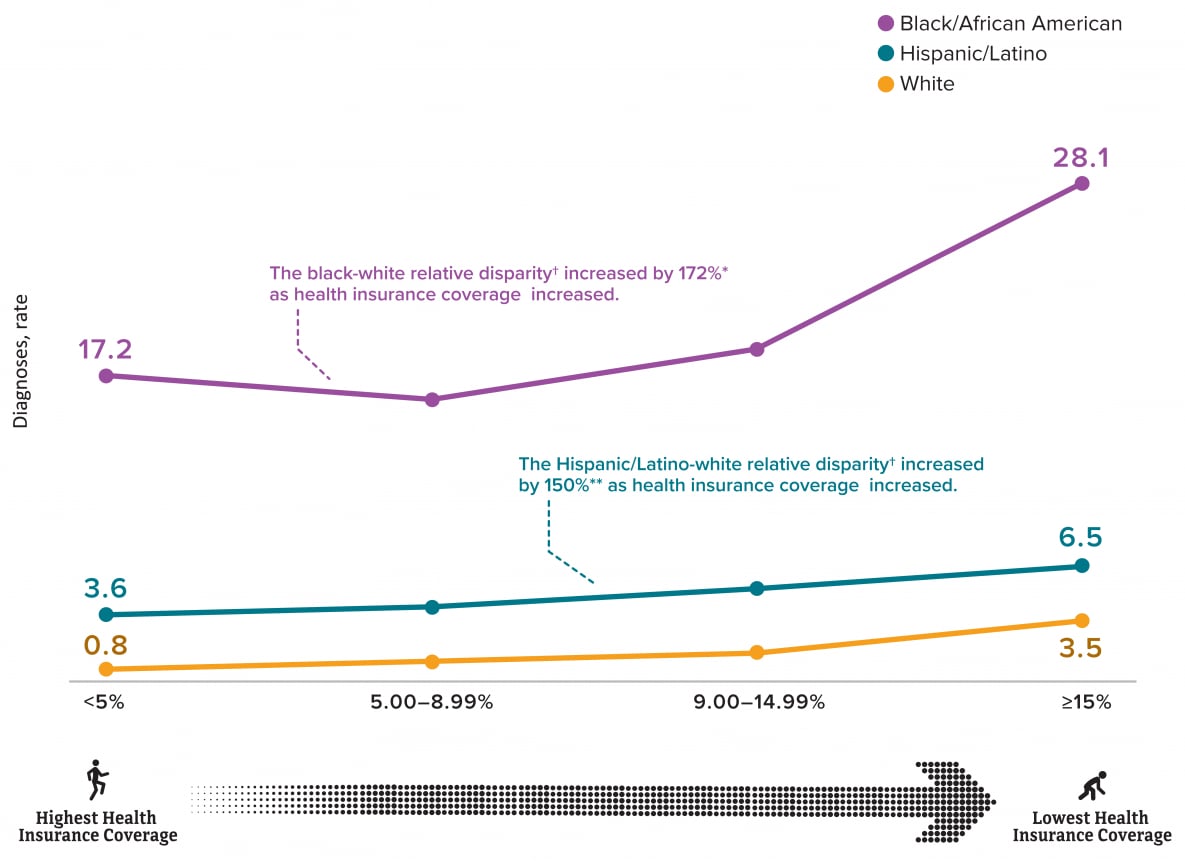
‡absolute disparity measures the difference between a group with the lowest rate and the group with the highest rate.
†relative disparity measures the ratio of the difference between the group rate and the overall population rate to the overall rate.
*172% increase is the lowest health insurance coverage (28.1/3.5) compared to the highest health insurance coverage (17.2/0.8).
**150% increase is the lowest health insurance coverage (6.5/3.5) compared to the highest health insurance coverage (3.6/0.8).
Figure 21. Diagnoses of HIV infection among adults, race/ethnicity, sex at birth, and Gini index, 2018—census tract level, United States and Puerto Rico

Note. Hispanics/Latinos can be of any race
Figure 22. Diagnoses of HIV infection among adults, age group, sex at birth, and Gini index, 2018—census tract level, United States and Puerto Rico

Figure 23. Diagnoses of HIV infection among adults, by transmission category, sex at birth, and Gini index, 2018—census tract level, United States and Puerto Rico
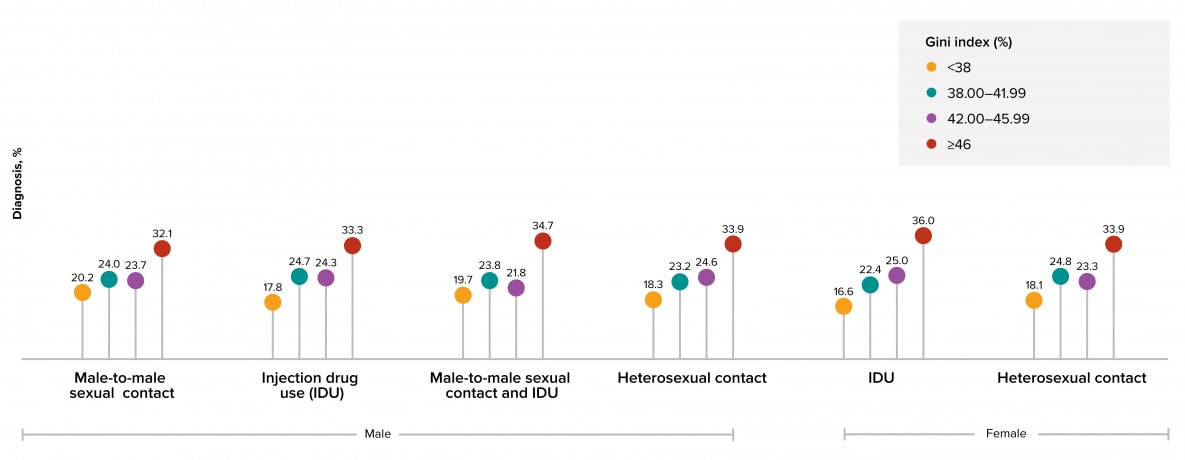
Note: Data have been statistically adjusted to account for missing transmission category. See Data Tables, Definitions, and Acronyms for more information on transmission categories.
Figure 24. Disparities of diagnoses of HIV infection among adults, by sex at birth and Gini index, 2018—census tract level, United States and Puerto Rico
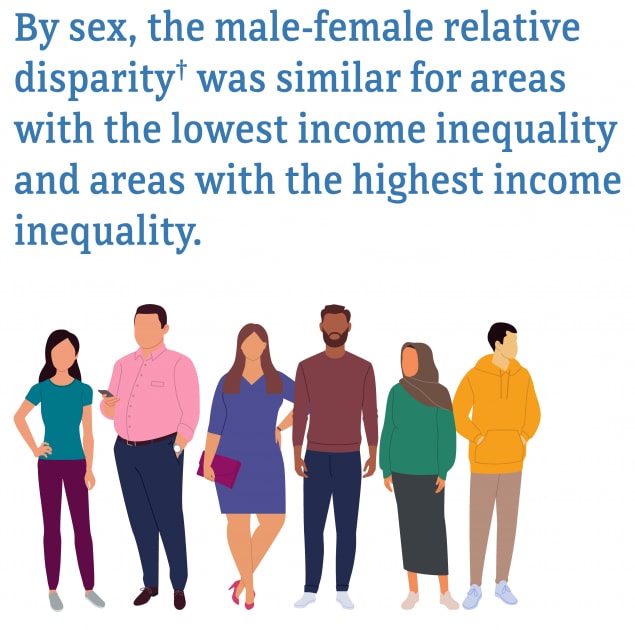
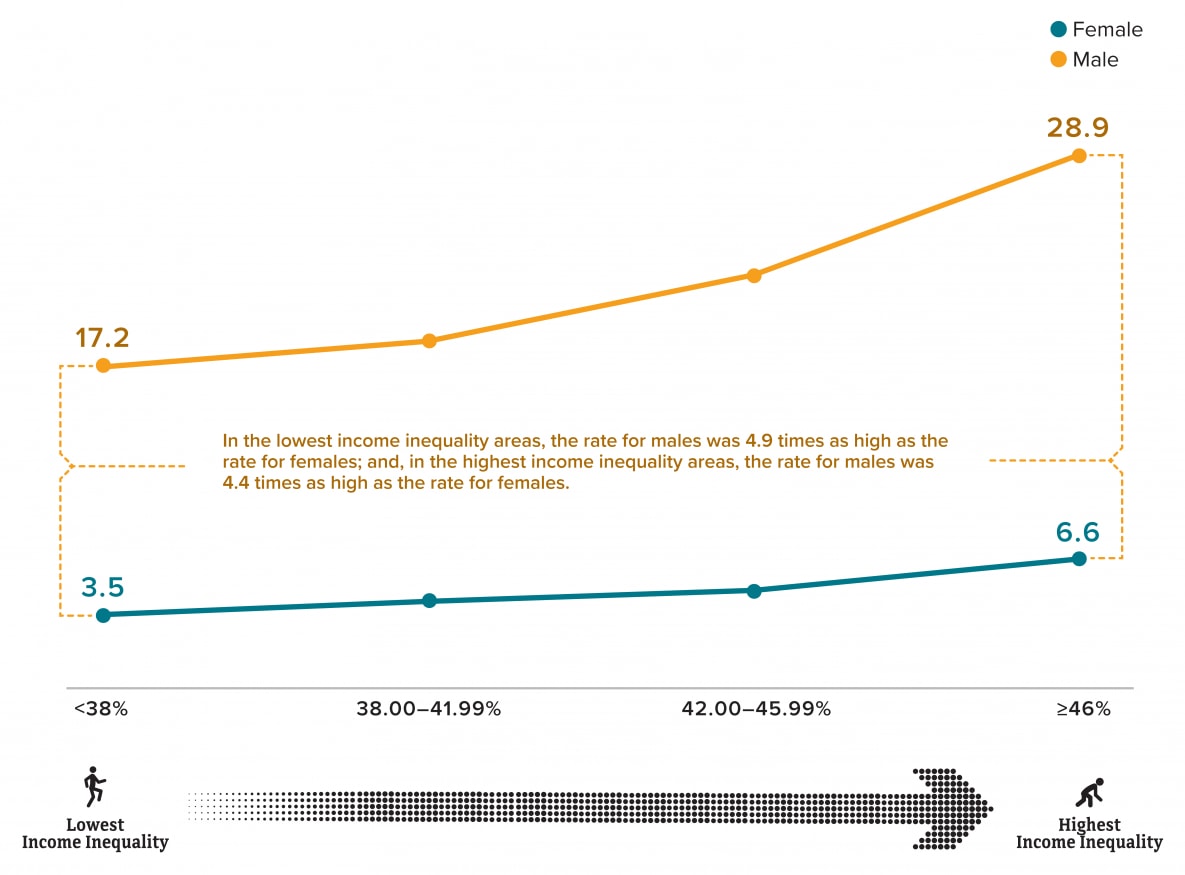
Figure 25. Disparities of diagnoses of HIV infection among adult males, by race/ethnicity and Gini index, 2018—census tract level, United States and Puerto Rico
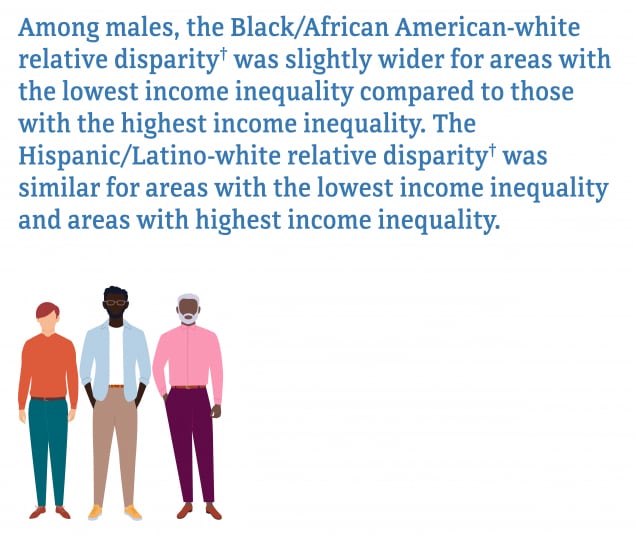
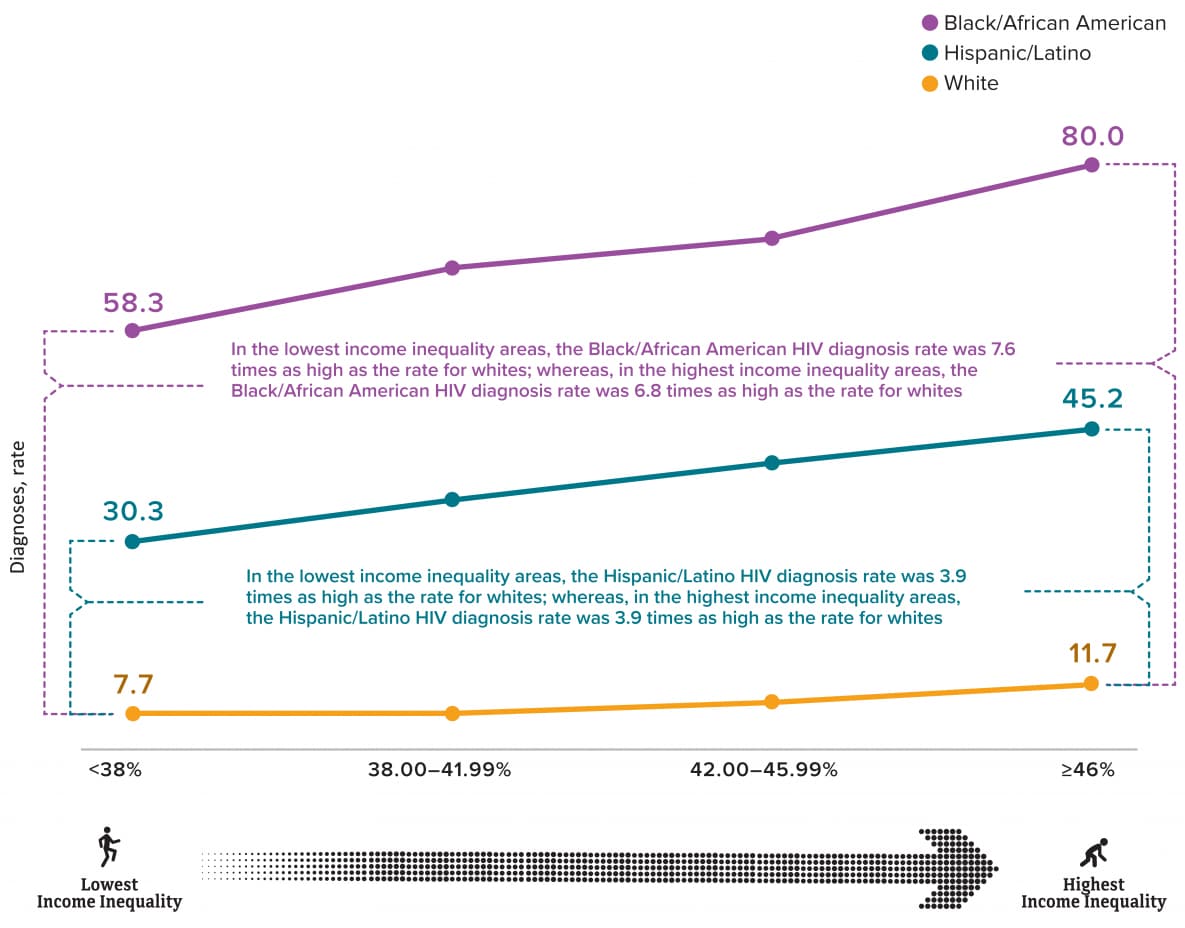
†relative disparity measures the ratio of the difference between the group rate and the overall population rate to the overall rate.
Figure 26. Disparities of diagnoses of HIV infection among adult females, by race/ethnicity and Gini index, 2018—census tract level, United States and Puerto Rico
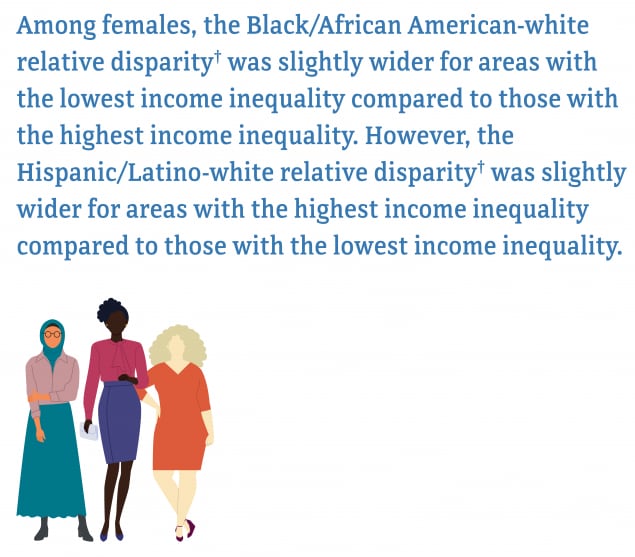
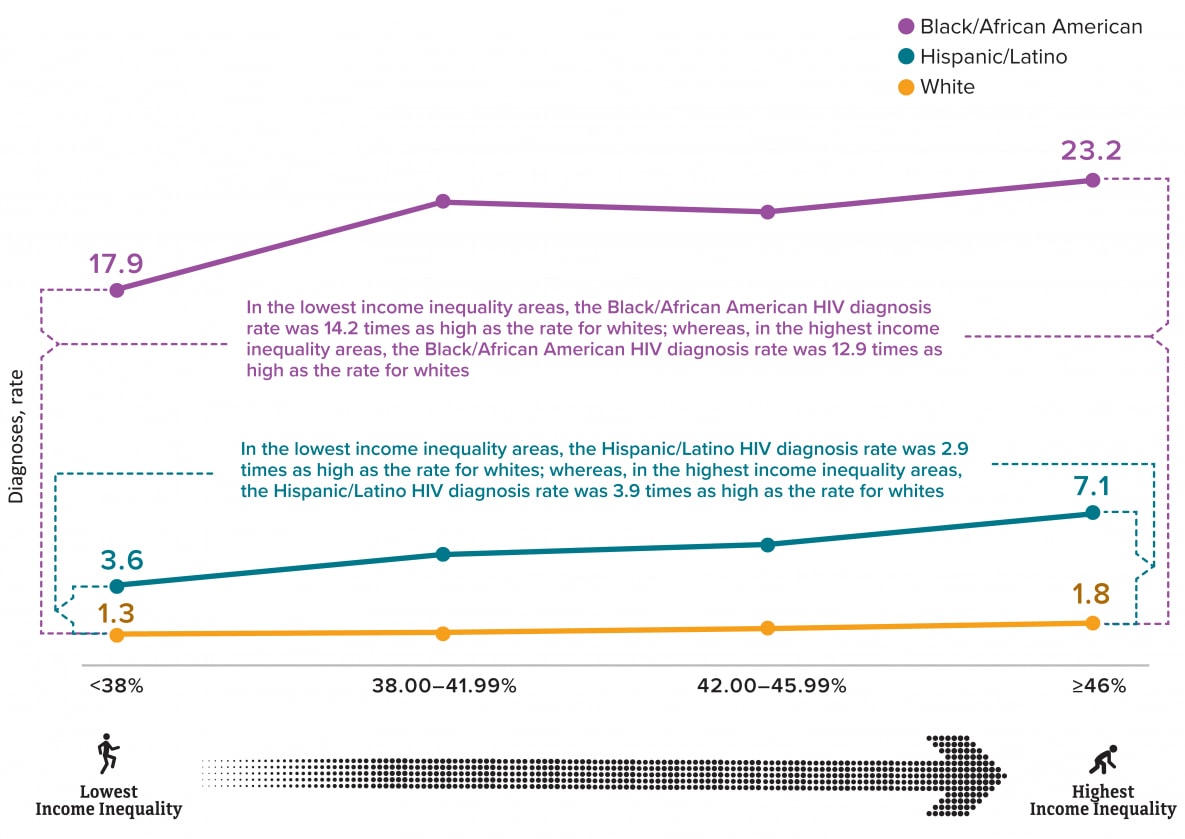
†relative disparity measures the ratio of the difference between the group rate and the overall population rate to the overall rate.
